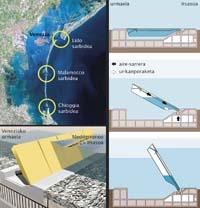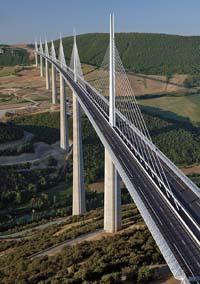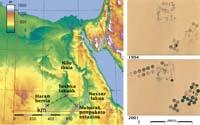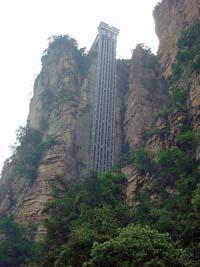Taller, longer, larger… more admirable…
Langeled gas pipeline: longest submarine pipeline

The gas pipeline crosses areas of high erosion. For this reason, in some areas it has had to protect against erosion. In addition, one of the main challenges this gas pipeline faced was the cliffs of Easington: They are about 20-25 meters high and suffer a great erosion. This is why it is a protected area and gas pipes cannot be built in any way. To combat it, the seabed was dragged and the pipe was channeled through a curved microtunnel, with exit to 15 kilometers from the coast.
MOSE Project: the largest and largest flood defense project
Venice is sinking. Built on the clay soil, the Venetian buildings are slowly sinking. In addition, when the sea rises, the city is flooded and salt water causes serious problems in the foundation of buildings.

In the last year, Venice has flooded twice a month and experts anticipate an increase in the level of Mediterranean waters. For this reason, a system is being built that protects the city from the growth of the sea: To the lagoon of Venice they will put the doors.
A series of 20 metre long metal containers and 5 in diameter are being built on the exits of the Venetian pond. These vessels are submerged, attached to the seabed. In situations of risk, these containers will be filled with water in concrete bases. In case an abnormal tide arrives, air will be introduced in the containers through a pump and water will be removed. The boat, when losing weight, will climb, the end will leave the water and can be used as a wall.
In this case, opinions contrary to the project have also been generated. In fact, taking into account the forecasts of rising speed of the Mediterranean Sea, it is estimated that for four months a year the walls must remain closed, which will cause the detention of the waters of the pond. In addition, according to these forecasts, by the year 2100 these walls will not be sufficient to protect Venice.
Millau Viaduct: the highest bridge in the world

This gigantic and slender bridge crosses the valley of Tarn, in France, giving way to the A75. It has the name of Millau at his feet. It took three years to build a concrete and steel bridge, using the most advanced techniques --GPS, laser, special layers for materials, self-lifting formwork...-. In addition, due to its height, a special technique was used to connect the parts of the bridge platform. Once the columns were finished, several cranes of the same height were placed. At one end of the bridge, the entire bridge was mounted on the ground. Later, from the arista, it was dragged above the columns and cranes to the other side of the valley. Thus they formed the bridge.
The Three Cencerros Dam: the largest hydroelectric dam
This terrible dam is expected to end in 2009. It will have 32 turbines that will generate 100 terawatios per year. From this dam will come 10% of China's energy demand.

However, it has been a highly discussed project. With the construction of the dam, 19 cities and more than 300 villages will be flooded - a total of 630 km 2 -, two million inhabitants will move, cause an enormous ecological impact and some treasures will be lost from the Paleolithic, Neolithic and Ming and King dynasties.
In addition, experts consider that there are design failures, and expect it to generate operating problems. For example, they say that the river will transport a huge amount of waste to the dam, which will prevent the operation of the turbines. Therefore, the performance and life of the dam will be reduced. In addition, experts have denounced the obsolescence of the techniques used urgently and have warned of the catastrophe that can provoke a prey of this magnitude.
Big Dig: The largest and most expensive construction project in US history
Imagine the city of Boston. 230 km 2 --four times Donostia- and 600.000 inhabitants. Now think you have to drill 14 million m 3 of the city's underground floor -- enough to cover the surface of Durango with a meter in height -- with the smallest number of obstacles on its surface. And this without prejudice to the meters, railways and other infrastructures that already cross the city below. In addition, it adds to the project another tunnel to the airport, a bridge to cross the Charles River and the construction of green areas in the hollow that would leave the old motorway. It's clear why it's big and expensive, right?

A similar problem arises at another point, since the new tunnel passes under the train station. In this case, they developed a special cat that allowed to maintain all the weight of the station and work underground. In addition, land freezing techniques were used to make work easier and safer, since when the earth freezes it becomes more stable.
Currently, under the city of Boston there is a network of motorways of 8-10 lines, with significant reductions in traffic problems and a total investment of 14,000 million dollars.
Toshka Project: They will transform 200 hectares of desert land into arable land

The Nile basin was the birthplace of one of the largest civilizations in the world. But in Egypt, beyond the river basin, there is a huge desert. Or should we say that it was expanded? In fact, at the beginning of the century the project called Toshka was inaugurated, an ambitious project that has turned the desert into a cultivable land. Between the lakes of Nasser and Toshka has been built a channel of 320 km that transports water. To avoid problems of filtration in transport, the channel has layers of cement, sand, concrete and polymer. In addition, the Mubarak water pumping station has been built, which pumps 25 million m 3 of water per day.
From this channel will leave other smaller channels, with a total of 200 hectares of land of sowing. According to the first experiments, these new plots are fertile and have already received cotton, cucumbers, tomatoes, watermelons, bananas, grapes and wheat. With this project, three million new jobs will be created by 2020 and Egyptian rural land will increase by 10%.
Bailong: higher and heavier outdoor lift

Despite being a miracle of engineering, he is very concerned about its visual impact on the long-term environment, but also about the damage that tourists can cause. Organizations such as the Natural Protection Faculty of Zhangjiajie Environmental Protection Bureau have repeatedly requested the closure and disassembly of the lift and, although it remained closed for a while, is still functioning today for the interests of local governments.





